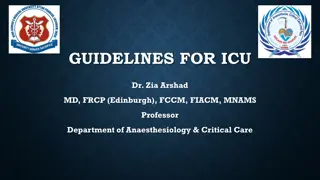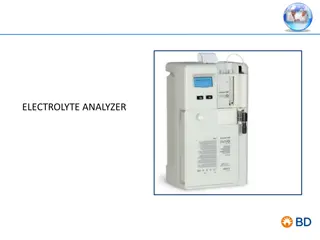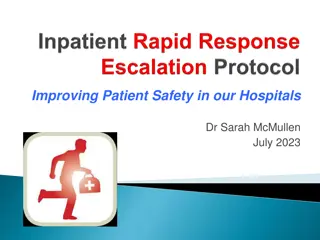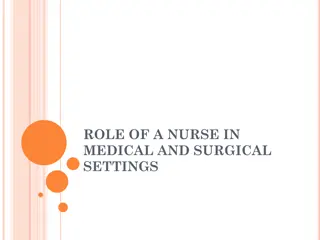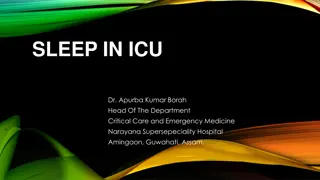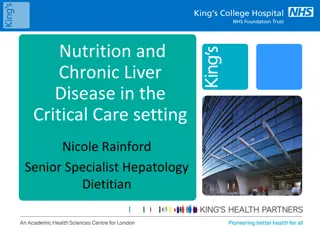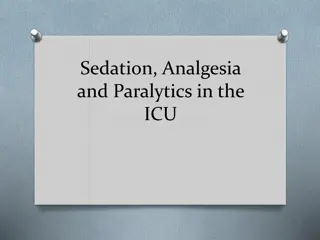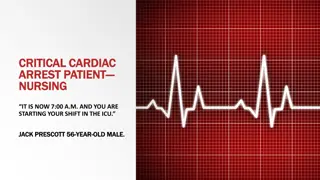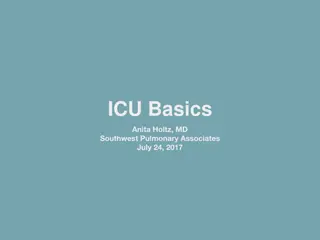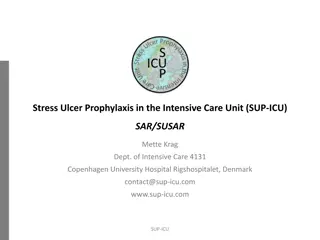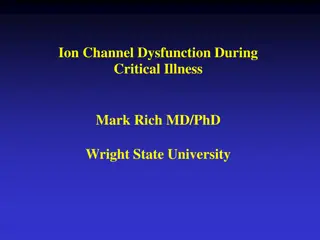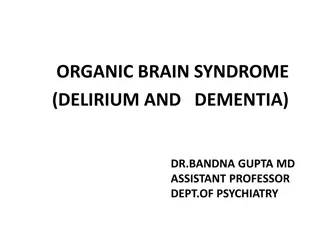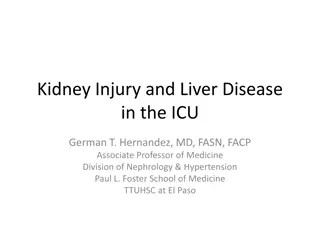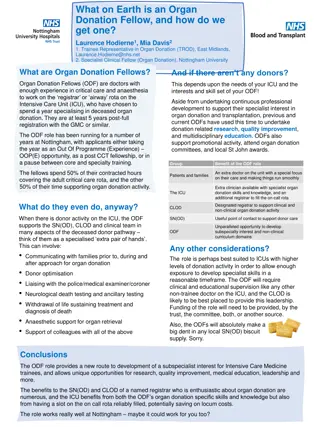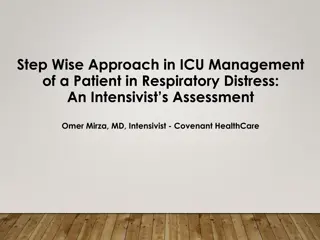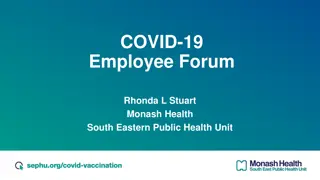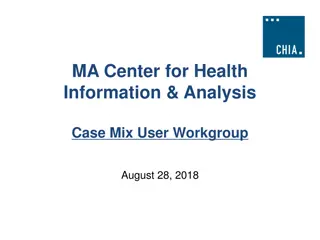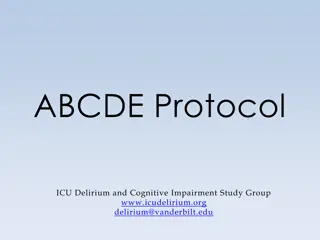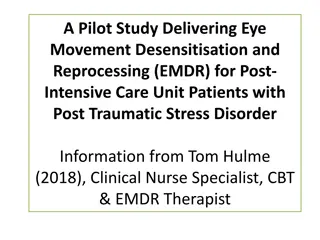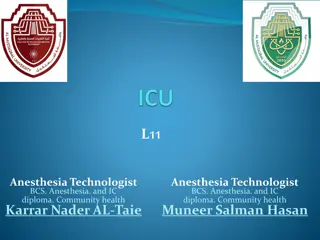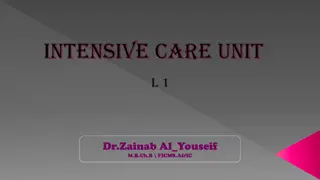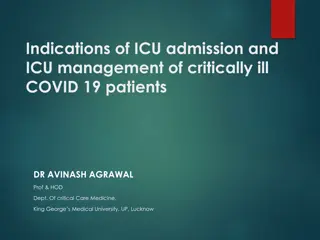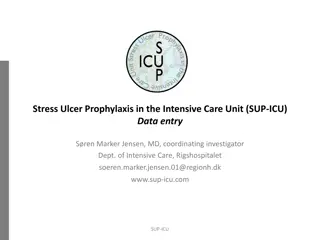Comprehensive ICU Protocol for Sedation, Analgesia, and Delirium Control by Dr. Vinod Srivastava
This comprehensive ICU protocol by Dr. Vinod Srivastava, an Associate Professor in Anaesthesiology & Critical Care at KGMU, covers key aspects such as sedation, analgesia, delirium assessment and control, stress ulcer and deep vein thrombosis prophylaxis, and glycaemic control in the ICU setting. Th
1 views • 50 slides
Guidelines for Intensive Care Unit (ICU) Management by Dr. Zia Arshad
Dr. Zia Arshad provides comprehensive guidelines for managing patients in the ICU, including admission criteria, monitoring protocols, handling lab investigations, communication procedures, and post-mortem care. The guidelines emphasize meticulous documentation, compassionate patient care, infection
0 views • 28 slides
Understanding Antibiotic Therapy in the ICU: Strategies and Considerations
Delve into the world of antibiotic therapy in the intensive care unit (ICU) with a focus on identifying the enemy pathogens, selecting the appropriate antibiotics, and formulating effective treatment plans. Explore the nuances of Gram-positive and Gram-negative bacteria, along with other key bacteri
4 views • 76 slides
Fluid Management in ICU: Understanding Body Fluid Compartments and Types of Fluids
Fluid management in the ICU is crucial for patient care. This includes understanding the distribution of body fluid compartments, such as intravascular, interstitial, and intracellular fluids. Different types of fluids like crystalloids and colloids play essential roles in treatment. Crystalloids ar
3 views • 26 slides
Nursing Care for Ventilator-Associated Pneumonia (VAP)
Ventilator-Associated Pneumonia (VAP) is defined as lung parenchyma inflammation occurring 48 hours or more after endotracheal intubation and mechanical ventilation initiation. It is a common nosocomial infection in ICU patients, with significant morbidity and mortality rates. Etiology of VAP involv
2 views • 24 slides
Understanding Electrolyte Analyzers in Medical Settings
Electrolyte analyzers play a crucial role in monitoring electrolyte levels for patients in various medical scenarios, including emergency departments, ICU admissions, and those with liver and kidney disorders. This technology utilizes Flame Emission Photometry and Ion Selective Electrode (ISE) techn
5 views • 6 slides
COVID-19 Update and Vaccination Status in Victoria as of June 21, 2023
Hospitalisation summary shows a decrease in COVID+ patients in hospital and ICU. Wastewater genomics provide insights into case incidence. Statewide deaths have decreased slightly. Excess deaths in Victoria are compared across years, and vaccination coverage data highlights the need for boosters in
2 views • 7 slides
Case Study: Management of Acute Esophageal Varices Bleed in a Patient with Cirrhosis
John Adams, a 55-year-old male with a history of alcoholism and cirrhosis, was admitted to the ICU with acute esophageal varices bleed. Despite abstaining from alcohol and active participation in Alcoholics Anonymous, he developed complications requiring immediate medical attention. The case involve
3 views • 32 slides
Improving Patient Safety in our Hospitals
Dr. Sarah McMullen discusses the importance of early recognition and treatment of clinical deterioration in hospital settings to improve patient outcomes. Key points include identifying abnormal clinical antecedents, implementing early warning systems like NEWS2 and CHEWS, screening patients for cri
3 views • 35 slides
Role of a Nurse in Medical and Surgical Settings
The primary role of a nurse in medical and surgical settings is to provide direct care to adult patients in various healthcare facilities such as hospitals, clinics, homes, and surgical centers. Nurses play a crucial role in outpatient departments (OPD), inpatient departments (IPD), intensive care u
0 views • 16 slides
Understanding Sleep Patterns and Architecture in the ICU Setting
Sleep in the ICU is crucial for physiological rest and emotional well-being, but it is often disrupted due to various factors. Normal sleep architecture consists of REM and Non-REM sleep cycles, each vital for different restorative processes. Non-REM sleep has three stages, including deep sleep impo
0 views • 25 slides
Understanding Ward Management in Healthcare Settings
Ward management involves optimizing resources in a ward to provide maximum care and comfort to patients. It includes functions like accommodation, treatment, recovery support, training opportunities, and research possibilities. Different types of wards exist, such as general wards and specific wards
2 views • 25 slides
Nutritional Considerations for Chronic Liver Disease in Critical Care
Malnutrition is common in chronic liver disease, leading to complications such as ascites and infections. Sarcopenia and weight loss are prevalent regardless of BMI. Critical care patients with liver disease face challenges due to limited physiological reserve, with main causes for ICU admission bei
1 views • 17 slides
Case Study: Management of Haemothorax Complicated by Pneumonia in a 62-Year-Old Patient
A 62-year-old patient with a history of COPD, AF, and metallic AVR on warfarin presented with left-sided chest pain and breathlessness. Initially diagnosed with a pleural effusion, subsequent imaging revealed a complicated parapneumonic effusion/empyema. Despite initial drainage and treatment, the p
0 views • 19 slides
Understanding Dysphagia in the ICU: Assessment and Impact
Dysphagia, the difficulty in swallowing, is a common issue in the ICU, affecting a significant percentage of intubated patients. It increases mortality, risk of pneumonia, malnutrition, and prolongs hospital stays. Assessment methods like bedside evaluation and FEES are crucial in managing dysphagia
5 views • 8 slides
Sedation, Analgesia, and Paralytics in the ICU: A Comprehensive Guide
This comprehensive guide delves into the use of sedatives, analgesics, and paralytics in the intensive care unit (ICU). It covers various medications like Etomidate, Propofol, Ketamine, Benzodiazepenes, and Dexmedetomidine, detailing their indications, dosages, and effects. Understanding the role of
0 views • 21 slides
Critical Cardiac Arrest Patient Nursing Scenario
In this scenario, you are starting your shift in the ICU with a critical cardiac arrest patient, Jack Prescott, a 56-year-old male. The learning objectives include recognizing septic patient symptoms, assessing hemodynamic status, initiating communication with a physician, and developing a care plan
0 views • 12 slides
Essential Tips for ICU Rotations
Prepare for your ICU rotation with these essential tips: read the orientation packet, educate yourself with original articles, prioritize patient stability, know your care team, and focus on learning and growth as an intern or resident. Be ready to identify sick patients, understand disease processe
0 views • 33 slides
Bringing Life Through Organ Donation: Two-Week Action Plan
Over the next two weeks, the Gift of Life aims to refocus on connecting with palliative care teams, educate ICU staff on the importance of early referrals, raise awareness in the Caribbean community about organ donation, coordinate information sessions with OPO liaisons, and encourage colleagues to
0 views • 64 slides
UK Sanctions and Financial Crime: Interplay, Types, Enforcement, and Offences
The UK sanctions landscape post-Brexit, governed by the Sanctions and Anti-Money Laundering Act 2018, focuses on financial sanctions, human rights, anti-corruption measures, immigration, trade, and transport sanctions. The system allows for the issuance of licenses for specific activities under sanc
0 views • 13 slides
Stress Ulcer Prophylaxis in ICU - Adverse Reactions Reporting Guidelines
Guidelines for reporting adverse reactions in Stress Ulcer Prophylaxis in the Intensive Care Unit (SUP-ICU), including definitions of Adverse Reactions (AR), Serious Adverse Reactions (SAR), Adverse Events (AE), Serious Adverse Events (SAE), SARs in SUP-ICU, and SUSARs. Specific conditions considere
0 views • 8 slides
Understanding Ion Channel Dysfunction in Critical Illness
An intriguing case study presents a young male with weakness and coma in the ICU following pneumonia and sepsis. Nerve conduction results indicated critical illness myopathy and polyneuropathy, along with cardiac abnormalities. Reduced muscle excitability was attributed to a sodium channelopathy. Th
0 views • 14 slides
Risk Management & MPTF Portfolio Analysis at Programme Level for UN Somalia
This session delves into the world of risk management and portfolio analysis at the programme/project level, specifically focusing on the Risk Management Unit of the United Nations Somalia. It covers enterprise risk management standards, planned risk management actions, the role of RMU, joint risk m
0 views • 30 slides
Understanding Organic Brain Syndrome & Delirium
Overview of organic brain syndrome and delirium, including definitions, clinical features, and management. Delirium, a common psychiatric syndrome, affects consciousness, cognition, and perception, leading to increased morbidity and mortality. Recognize core symptoms, such as disturbances in conscio
0 views • 37 slides
Impact of Physiotherapy on ICU Patients: A Comprehensive Study
Investigating the impact of physiotherapy interventions on ICU patients, this study reveals findings on muscle weakness, reduced mobility, chronic pain incidence, and referral patterns post-ICU discharge. The study aims to improve patient outcomes through tailored interventions and follow-ups.
0 views • 11 slides
Understanding Network Management Processes in Computer Networks
Network management processes play a vital role in maintaining the efficiency and security of computer networks. This includes fault management, configuration management, accounting management, performance management, and security management. Syslog, a standard for computer message logging, is utiliz
0 views • 78 slides
Understanding Kidney Injury and Liver Disease in the ICU
This presentation delves into the intricacies of acute kidney injury (AKI) and its occurrence in patients with liver disease in the intensive care unit (ICU). It covers the definitions, classifications, and causes of AKI, emphasizing the Hepatorenal Syndrome, a form of functional renal failure in en
0 views • 29 slides
Understanding the Role of Organ Donation Fellows in Intensive Care Units
Organ Donation Fellows (ODFs) are experienced doctors specializing in deceased organ donation, spending time on the ICU rota and supporting organ donation activities. They assist in donor optimization, communication with families, and organ retrieval, benefiting both ICU patients and the healthcare
0 views • 4 slides
Understanding Common Equipment and Systems in ICU
Common equipment in an ICU includes mechanical ventilators, cardiac monitors, monitoring equipment for bodily functions, and a variety of tubes, lines, and pumps. Drugs like analgesics are used to reduce pain and prevent infections. Monitors track heart rate, blood pressure, and temperature, while t
0 views • 48 slides
Step-Wise Approach in ICU Management of a Patient in Respiratory Distress
An intensivist outlines a systematic approach for managing an acutely unstable patient in respiratory distress in the ICU. The process includes clinical assessment, noninvasive ventilation options, considerations for vital organ functions, and potential pitfalls to avoid. Emphasis is placed on diffe
0 views • 52 slides
COVID-19 Response and Vaccination Impact in Victorian Health Unit
In the COVID-19 Employee Forum by Rhonda L. Stuart from Monash Health South Eastern Public Health Unit, various aspects like the current state, data from the last 6 months, and hospitalizations are discussed. It also highlights the effects of vaccination in preventing hospitalizations, ICU admission
0 views • 20 slides
MA Center for Health Information & Analysis Case Mix User Workgroup Updates
Center for Health Information & Analysis provides updates on the FY17 Case Mix Data Release, including information on patient disposition in outpatient emergency departments, ICU utilization changes, and release timeframes for various data files. The updates cover repeat and new applicants, resubmit
0 views • 19 slides
Exploring ICU Education Experience in London During COVID Pandemic
Survey results of doctors redeployed to ICU in London reveal the London Transformation & Learning Collaborative (LTLC) program aims to enhance staff preparedness, share best practices, and improve patient outcomes through consistent training and collaboration. The LTLC program focuses on increasing
0 views • 20 slides
ABCDE Protocol and MIND-USA: Enhancing Critical Care Practices
Explore the importance of the ABCDE Protocol in managing ICU patients, focusing on sedation, analgesia, and the prevention of delirium. Learn about the potential drawbacks of sedative therapies and the need for coordinated care in critical care settings. Discover the MIND-USA ABCDE Protocol, emphasi
0 views • 43 slides
Delivering EMDR for PTSD in Post-ICU Patients: A Pilot Study by Tom Hulme
More ICU survivors are experiencing PTSD post-discharge. Symptoms include intrusive thoughts, nightmares, avoidant behavior, and hypervigilance. EMDR therapy is recognized as effective. This pilot study aims to provide evidence-based treatment to improve health outcomes in this patient group.
0 views • 10 slides
Nutritional Therapy in the ICU: Enteral and Parenteral Nutrition Overview
Nutrition is crucial in ICU care to provide adequate calories and protein for patients. This involves enteral nutrition via tubes and parenteral nutrition through IV solutions. Enteral feeding should begin within 24-48 hours if the GI tract is functional, while parenteral nutrition includes dextrose
0 views • 13 slides
Evolution of Intensive Care Units: From Harvey Cushing to Modern Healthcare
Intensive care units (ICUs) have evolved through the meticulous practices of pioneers like Harvey Cushing, who emphasized post-operative care and infection control. As surgical procedures advanced, ICUs became crucial in saving lives during critical medical conditions. From reducing mortality rates
0 views • 23 slides
ICU Education Experience Across London During COVID Pandemic Survey Results
Explore the outcomes of the London Transformation & Learning Collaborative (LTLC) program focusing on enhancing critical care staffing and education in response to the COVID-19 pandemic. The initiative aims to cross-skill staff, expand ICU capacity, and optimize workforce capabilities to manage curr
0 views • 19 slides
Overview of ICU Admission and Management for Critically Ill COVID-19 Patients
There are various strains of coronavirus with Sars-cov-2 causing COVID-19. The virus is transmitted through droplets and has an incubation period of 2-14 days. Clinical features range from mild illness to critical disease with a fatality rate of 2.3-5%. Criteria for ICU admission include the need fo
0 views • 27 slides
Stress Ulcer Prophylaxis in ICU Data Entry System - SUP-ICU Overview
Dive into the Stress Ulcer Prophylaxis in the Intensive Care Unit (SUP-ICU) data entry system led by Dr. Soeren Marker Jensen. Explore screening, randomization, site overview, and data entry processes. Access participant details, edit submitted data, and learn about data entry guidelines. Enter the
0 views • 28 slides

